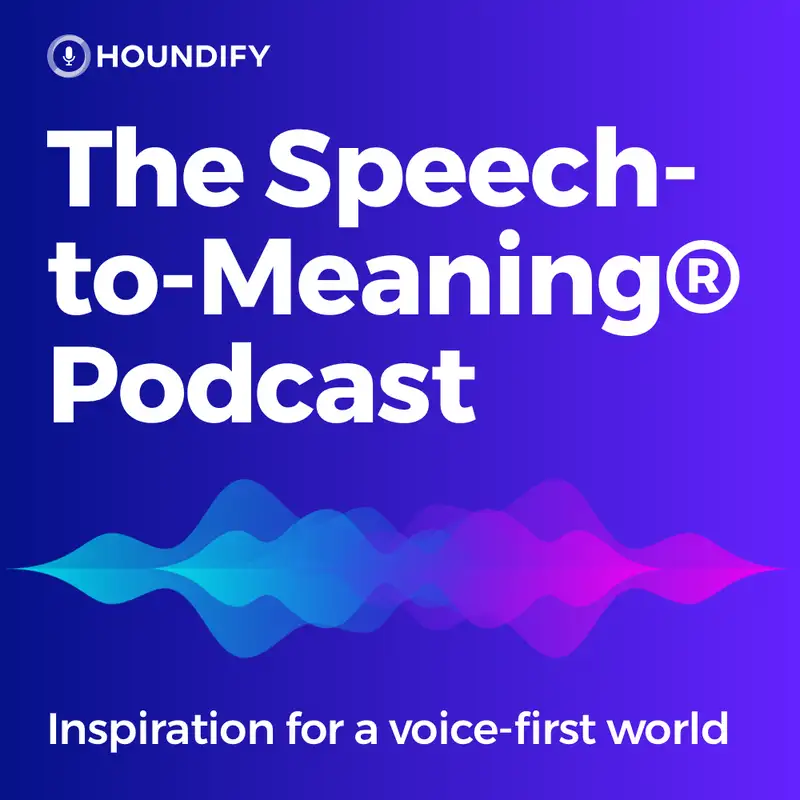Bringing Inspiration to a Voice-First World
Welcome to the first episode of the Speech-to-Meaning(R) Podcast by SoundHound!
This brand new series is set to inspire you - our listeners - and help generate excitement and innovation in a voice-first world.
SoundHound believes every brand should have a voice. This belief has inspired the creation of Houndify, SoundHound’s independent Voice AI platform.
Houndify allows developers to build a custom voice assistant with a branded wake word for any product or service. And their proprietary Speech-to-Meaning™ engine produces results with unprecedented speed and accuracy.
SoundHound’s mission is to enable humans to interact with the things around them the way we interact with each other: by speaking naturally to phones, cars, smart speakers, mobile apps, coffee machines, and every part of the emerging ‘voice-first’ world.
In today’s show, host Carl Robinson leads the discussion about one of these devices - the indispensable smartphone.
This episode is an edited version of a recent Houndify webinar discussion, moderated by Carl, and featuring four impressive expert panelists from big-name organizations:
- Peachy-Jean Retizos from Meredith Corporation
- Jordan Kooijman from Aisle Ahead and BigOven
- Simon Sidhom from SiriusXM & Pandora
- Brandon Kaplan from Skilled Creative
The panel discusses how and why voice-enabled mobile apps are rapidly growing in popularity with brands, and how much easier voice-enabled apps are to create, compared to non-voice apps.
The panelists share their recent experiences in the time of the pandemic, which has significantly accelerated usage and development of voice tech. They explore challenges, longer and short-term strategies, and ideas for the future.
Voice-first is the topic of the moment. Some big announcements in voice AI have been made this year. Voice usage is in rapid growth across a range of use cases.
For more details on SoundHound and Houndify, visit soundhound.com
Highlights
- Brands and organizations are trying to figure out: “What are we trying to achieve? How do we launch something? How do we add value into the ecosystem?”.
- Being home is leading to more usage of voice assistance all across all things.
- One of the things that has really driven [voice] is voice interactions have become actually useful. They're faster than using it on any other device.
- Having a standalone voice interaction within the (voice assistant) is a powerful tool that is available to us. So it put it on the roadmap, absolutely.
- Multimodal design is huge. Being able to choose as a user, whether you want to continue with your voice, or switch to an on screen experience is really an interesting use case.
- Voice conversations are pretty tough. [It’s about] being able to know when to ask a question, and then how to respond, how to process a user's response, especially if it's not one of the ones that you were expecting them to say.
- The overall challenge that's continuous is retention, and making sure that we're optimizing continuously for that.
- We opened a development office in Greece because of the need for our mobile app developers; Finding them in the United States was quite a challenge.
- Compared to app development, voice tech development is streamlined; it’s done for one device, for one platform.
- For voice integration, by using some of the functionality we can get out of the box, you can really develop much faster. You can get that first version out and to your users very quickly.
- Voice ads give us an opportunity to prompt the user to engage. Ask them to say yes or no at the end of the ad. If the user says yes, they'll get more information, orbe directed towards whatever the advertiser wants.
- We saw a large percentage of people who like or love interacting with ads with their voice. And through our beta, we've seen higher engagement rates as it relates to voice, versus an on screen advertisement.
Quotes from the show
[04:42] Voice is still nascent, but it's matured in terms of how brands [are] testing and learning.
[05:48] People understand the scale and the distribution of voice now, not just as a channel, but a user interface.
[07:44] People are getting more used to voice assistants, and they're gaining trust in them.
[09:05] Having that ability to just speak naturally . . . it makes it so much more seamless for users.
[17:26] [Brands] should also have the ability to allow users to choose what's on the screen by using their voice.
